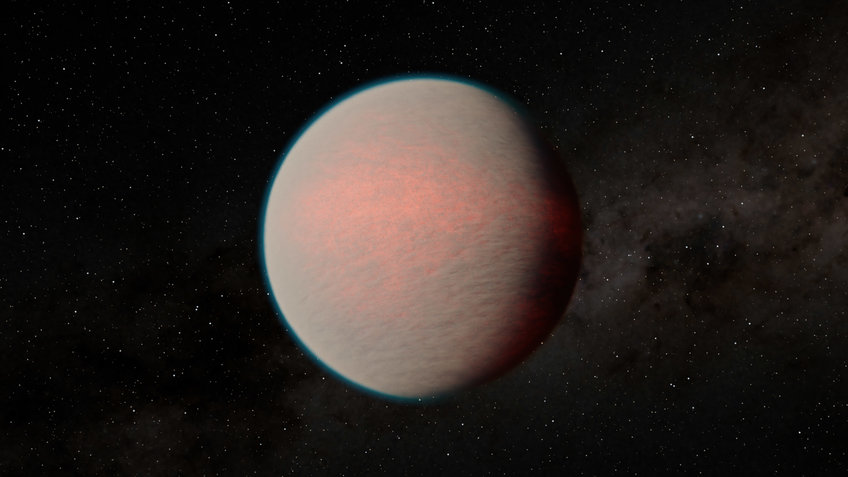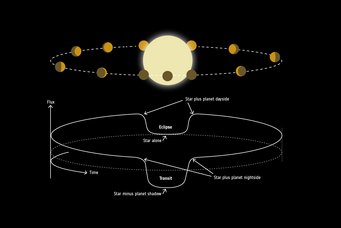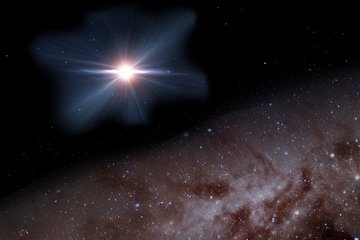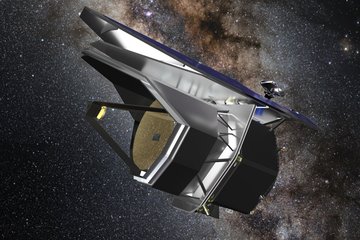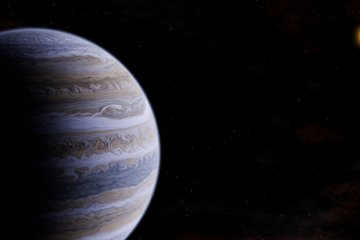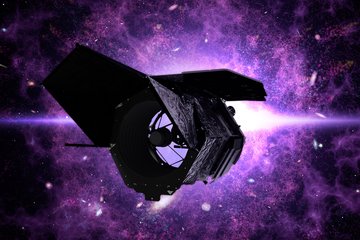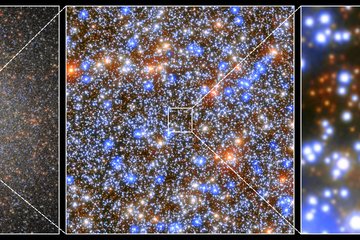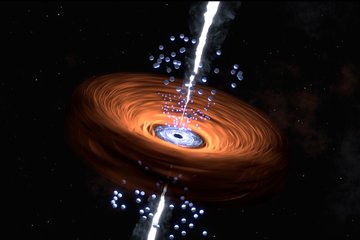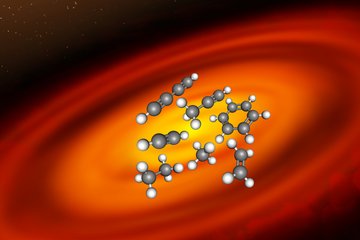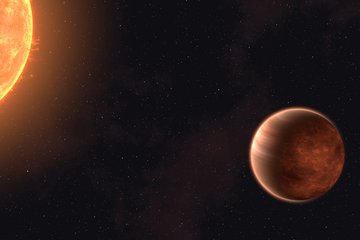A reluctant exoplanet lifts its veil – a bit
The James Webb Space Telescope reveals details of the atmospheric composition of the Mini-Neptune GJ 1214 b
After almost 15 years of futile efforts, an international team of researchers involving the Max Planck Institute for Astronomy has determined some of the atmosphere’s properties of the exoplanet GJ 1214 b. To this end, astronomers have now measured the infrared radiation of the planet classified as a Mini-Neptune with the MIRI spectrograph of the James Webb Space Telescope (JWST) and evaluated it with the help of model calculations. The results indicate an unusually highly reflective, dense haze in the upper atmosphere and show evidence of water vapour and methane.

“Our results show that the haze layer of GJ 1214 b must have a composition different from known celestial bodies,” says Maria Steinrueck from the Max Planck Institute for Astronomy (MPIA) in Heidelberg, Germany. She is a co-author of the paper, which appears in the journal Nature, and performed the model calculations essential for evaluating the observations.
A dense, highly reflective veil
The data can only be explained by the researchers’ assumption of a layer in the planet’s upper atmosphere that reflects the radiation from the central star, which GJ 1214 b orbits once in 38 hours, unusually well. Exactly what this layer consists of, however, remains a mystery, as none of the compositions suspected so far provides a satisfactory explanation. At least, the usual candidates have been ruled out.
“Neither soot particles nor so-called tholins reflect the star’s radiation sufficiently strongly,” Steinrueck states. The term “tholin”, coined by Carl Sagan, describes a variable mixture of hydrocarbons found on Saturn’s moon Titan and other bodies in the Solar System. Presumably, the atmosphere of the primordial Earth also consisted partly of tholins.
Similar to how the ozone layer on Earth reacts with the Sun’s UV radiation, analogous processes could also be responsible for the production of the chemical compounds of the haze found in the upper atmosphere of GJ 1214 b and perhaps many Mini-Neptunes. Intensive research is being carried out in various laboratories to determine which substances these could be. Organic compounds are currently the hottest candidates.
Evidence of water
The new observations with MIRI (Mid-Infrared Instrument) on board JWST for the first time also prove that the atmosphere beyond hydrogen and helium must have a high fraction of heavy elements. This follows from the model calculations that reproduce the measured variation in brightness of the starlight reprocessed by the planet.
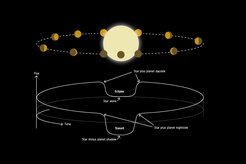
With their observations, the astronomers have captured a complete orbit of GJ 1214 b and thus measured its surface from all sides – a first for a Mini-Neptune. The light GJ 1214 b receives from its central star serves as a probe. Any interactions of the planet with the starlight will then show up in fluctuating proportions of the planet’s radiation.
The measurement data also indicate the concrete composition of the atmosphere. As already suspected, this planet probably has water, which appears as gaseous vapour. “GJ 1214 b could therefore be a water world,” says Eliza Kempton, professor at the University of Maryland, USA and lead author of the research article. However, the features could also indicate methane gas. A mixture of both is also conceivable. Further observations are therefore needed to clarify the matter.
A planet with eternal day and night
In 2009, astronomers discovered GJ 1214 b, just under 50 light years away, using the transit method. In this method, the planet’s orbit is oriented in such a way that it regularly crosses its central star, and the occultation slightly reduces the star’s brightness. This measurement made it possible to calculate its size of 2.5 to 3 Earth diameters. Its mass is about seven Earth masses, classifying GJ 1214 b as a Mini-Neptune.
This type of exoplanet is the most common one that astronomers find. However, there are no such planets in the Solar System. That is one reason why their nature is poorly known.
GJ 1214 b orbits its central star, GJ 1214, at a distance of about one-seventieth of the distance between the Earth and the Sun. This means that the planet is in a so-called tidally locked rotation. In other words, it takes the same time to orbit the host star as the planet needs to rotate around its axis. Consequently, the host star always illuminates and heats the same side of the planet. Winds carry the air to the opposite hemisphere, where it cools in eternal night.
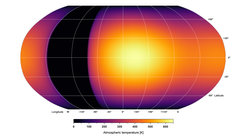
As with Earth’s global climate, the temperature on GJ 1214 b depends on various influences: the luminosity and temperature of the star, the distance of the planet from the star and the properties of the atmosphere. This results in a characteristic thermal radiation of the planet, which the researchers recorded with the MIRI observations. These consist of spectra that split the different parts of the infrared radiation according to their wavelength.
As a result, the astronomers conclude that the haze reflects half of the radiation from the central star without contributing to the heating of the atmosphere. The calculations thus show that GJ 1214 b has an average global temperature of about 230 degrees Celsius (500 Kelvin), which varies by about 115 degrees between day and night.
Breakthrough in planetary research
Scientists have tried several times to determine the composition of GJ 1214 b’s atmosphere by analysing the starlight penetrating its air layers at each transit. This process usually imprints distinct features of the gases on the light. However, previous observations showed nothing. The JWST has now opened a new chapter.
“GJ 1214b has been the white whale of exoplanet atmosphere characterisation – the whole community has been chasing it for a long time. It’s great to finally see some of its secrets revealed,” says a delighted Laura Kreidberg. She is a Director at MPIA and heads the Atmospheric Physics of Exoplanets (APEx) department, where Maria Steinrueck conducts research. Kreidberg was among the first to target GJ 1214 b to determine its composition.
These results represent a breakthrough in planetary research. They boost hopes that astronomers have found a tool to systematically study the most common class of exoplanets.
Background information
The MPIA researchers involved in the study are Maria Steinrueck and Sebastian Zieba.
The astronomers observed GJ 1214 b as part of the JWST General Observer (GO) Program 1803, “Unlocking the Mysteries of the Archetype Sub-Neptune GJ 1214b with a Full-Orbit Phase Curve” (PI: Jacob Bean).
The James Webb Space Telescope (JWST) is the world’s leading observatory for space exploration. JWST is an international programme led by NASA with its partners, ESA (European Space Agency) and CSA (Canadian Space Agency).
JWST’s Mid-InfraRed Instrument (MIRI), built by a European consortium of research institutions, is a multi-purpose scientific instrument for infrared wavelengths between 5 and 28 microns. It combines an imaging camera with a spectrograph. With the support of industrial partners, MPIA provided the mechanisms of all wavelength range steering elements, such as filter and grating wheels, and led the electrical design of MIRI.
The following research institutes are involved in this study:
University of Maryland, College Park, USA; University of Chicago, USA; Max Planck Institute for Astronomy, Heidelberg, Germany; Earth and Planets Laboratory, Carnegie Institution for Science, Washington, DC, USA; University of Oxford, UK; University of Michigan, USA; University of Leicester, UK; BAER Institute, NASA Ames Research Center, Moffet Field, USA; Institut Trottier de Recherche sur les Exoplanètes and Département de Physique, Université de Montréal, Canada; Center for Computational Astrophysics, Flatiron Institute, New York, USA; Johns Hopkins Applied Physics Laboratory, Laurel, USA; Steward Observatory, University of Arizona, Tucson, USA; European Space Agency, Space Telescope Science Institute, Baltimore, USA; Leiden Observatory, The Netherlands; AIM, CEA, CNRS, Université Paris-Saclay, Université de Paris, Gif-surYvette, France; Vanderbilt University, Nashville, USA; Center of Excellence in Information Systems, Tennessee State University, Nashville, USA; Lunar and Planetary Laboratory, University of Arizona, Tucson, USA; Eureka Scientific, Inc. , Oakland, USA; NASA Jet Propulsion Laboratory, California Institute of Technology, Pasadena, USA; Johns Hopkins University, Baltimore, USA; School of Earth & Space Exploration, Arizona State University, Tempe, USA; University of California, Santa Cruz, USA
MN
